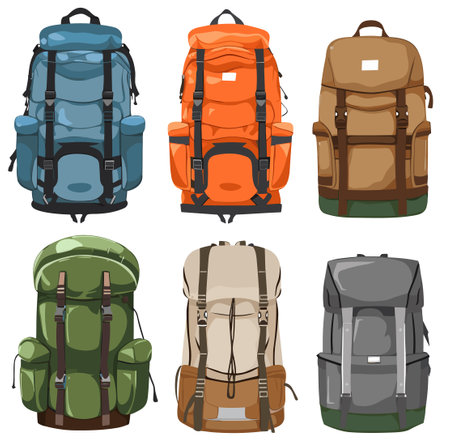1. Understanding Leave No Trace Principles
If you’re planning a multi-day hike in the American wilderness, understanding and practicing Leave No Trace (LNT) principles is essential. These guidelines help hikers minimize their environmental impact while enjoying the great outdoors. The LNT philosophy was developed to protect wild places for future generations, making sure everyone can experience nature’s beauty without damaging fragile ecosystems.
What Is Leave No Trace?
Leave No Trace is a set of seven core principles that guide outdoor enthusiasts on how to enjoy nature responsibly. These rules aren’t just about picking up trash; they cover everything from where to camp to how to interact with wildlife. In the United States, with its vast national parks and public lands, following these principles is especially important due to the high number of visitors each year.
Why It Matters in American Wilderness Settings
American wilderness areas are often remote and ecologically sensitive. Even small disturbances can take decades to heal. Popular camping spots can quickly become degraded if hikers don’t take care. By following LNT, you help preserve these places not just for yourself but for everyone else who loves the outdoors.
Overview of the Seven Leave No Trace Principles
| Principle | Description |
|---|---|
| Plan Ahead and Prepare | Know the regulations and special concerns for the area you’ll visit. |
| Travel and Camp on Durable Surfaces | Stick to established trails and campsites to avoid damaging vegetation. |
| Dispose of Waste Properly | Pack out all trash, leftover food, and litter; use restroom facilities or follow waste disposal guidelines. |
| Leave What You Find | Preserve the past: leave rocks, plants, and other natural objects as you find them. |
| Minimize Campfire Impact | Use a camp stove for cooking instead of making fires; keep fires small if allowed. |
| Respect Wildlife | Observe animals from a distance and never feed them. |
| Be Considerate of Other Visitors | Keep noise down and respect others’ experience in nature. |
The LNT principles are more than just rules—they’re a mindset that helps protect America’s wild places so that we can all continue to enjoy them for years to come.
2. Choosing a Low-Impact Campsite
Best Practices for Selecting Durable Surfaces
When setting up camp during multi-day hikes, picking the right spot is crucial for minimizing your environmental impact. The Leave No Trace principles encourage campers to use durable surfaces and existing campsites whenever possible. This helps protect fragile environments and prevents long-lasting damage to nature.
What Are Durable Surfaces?
Durable surfaces are areas that can handle repeated use without being damaged or worn out easily. Common examples include:
| Surface Type | Description | Why Its Good for Camping |
|---|---|---|
| Established Campsites | Previously used camping spots, often marked by compacted soil or clearings | Reduces new impact by reusing areas already affected by human activity |
| Gravel or Rock | Natural rocky ground or pebbled areas | Highly resistant to wear, little to no plant life to disturb |
| Dry Grass | Areas with thick, dry grass (not wet meadows) | Bounces back quickly after use; less chance of leaving a trace |
| Sandy Areas | Banks or clearings with sand or loose soil | No living plants to crush or roots to damage |
Avoid Sensitive Habitats
Stay away from delicate environments that cant recover quickly from disturbance. These include:
- Wet meadows and marshes—these areas are home to unique plants and animals and are especially easy to damage.
- Mossy or lichen-covered ground—these grow very slowly and take years to recover from trampling.
- Lakeshores and riverbanks—camp at least 200 feet (about 70 adult paces) away from water sources to protect wildlife access and prevent pollution.
Tips for Finding the Right Spot
- Look for established sites: Choose places where you see signs of previous camping, like flattened ground or fire rings. If these exist, use them instead of making a new site.
- Avoid expanding campsites: Keep your tent, kitchen, and gear within the smallest footprint possible to minimize your impact.
- Camp on bare ground when possible: If there are no established sites, pick areas with little vegetation where your presence won’t harm plant life.
- Respect “No Camping” zones: Some parks mark sensitive areas with signs—always honor these boundaries.

3. Setting Up Camp Responsibly
Guidelines for Tent Placement
Choosing the right spot for your tent is key to protecting both your gear and the environment. Follow these simple guidelines:
| Tent Placement Tip | Why It Matters |
|---|---|
| Use established campsites whenever possible | Prevents new damage to vegetation and soil |
| Pitch tents at least 200 feet from lakes and streams | Protects water sources from contamination and erosion |
| Avoid areas with fragile plants or mosses | Keeps sensitive ecosystems intact for future hikers |
| Look for flat, durable surfaces like gravel or dry grass | Minimizes long-term impact on the ground cover |
Setting Up a Low-Impact Camp Kitchen
Your camp kitchen can be both functional and eco-friendly with these Leave No Trace tips:
- Cook away from your tent: Set up your stove at least 70 steps (about 200 feet) from your sleeping area to keep smells away from where you rest.
- Avoid digging trenches: Use portable camp stoves instead of fire pits, which leave scars on the land.
- Use a tarp or ground cloth: Place it under your kitchen area to catch spills and crumbs, making cleanup easy and preventing animals from being attracted to your site.
- Dispose of food waste properly: Pack out all scraps or use designated bear-proof trash containers if provided.
Smart Gear Storage Solutions
Keeping your gear organized helps protect wildlife and the natural setting. Here are some practical ways to store your equipment responsibly:
- Hang food and scented items: Use a bear hang or bear canister to store food, toiletries, and trash away from your sleeping area.
- Avoid spreading out gear: Keep backpacks, shoes, and other items together on durable surfaces to limit trampling of vegetation.
- Protect gear from weather: Use tarps or rain covers instead of moving rocks or logs for shelter.
- No trace left behind: Before leaving camp, do a thorough sweep to pick up micro-trash—think twist ties, corners of wrappers, or dropped matches.
Campsite Setup Checklist
| Task | Leave No Trace Action |
|---|---|
| Tent Placement | Select established sites; avoid fragile areas; stay 200 feet from water sources. |
| Camp Kitchen Setup | No open fires; use stoves; keep food contained; clean up thoroughly. |
| Gear Storage | Bears in mind—hang food; group gear; check for forgotten items before leaving. |
4. Proper Waste Management
Tips on Human Waste Disposal
Managing human waste responsibly is key to protecting the outdoors and following Leave No Trace principles. When camping in the backcountry, always use designated toilets if available. If not, know how to properly bury your waste using the “cathole” method:
| Step | Description |
|---|---|
| Find a Spot | Pick a location at least 200 feet (about 70 steps) from water sources, trails, and campsites. |
| Dig a Cathole | Use a small trowel to dig a hole 6-8 inches deep and 4-6 inches wide. |
| Bury Waste | Do your business in the hole, then cover it with soil and natural materials. |
| Pack Out TP | Bring sealable bags to pack out used toilet paper and hygiene products. |
Managing Trash at Your Campsite
Packing out all trash is non-negotiable in American outdoor culture. Bring sturdy zip-top bags or stuff sacks for your garbage. Never burn trash or food scraps, as this pollutes the land and attracts wildlife. Remember, “pack it in, pack it out” is the gold standard. Here’s how you can keep your site spotless:
- Separate Waste: Use different bags for recyclables and trash.
- Inspect Campsite: Do a final sweep before leaving—check under rocks and logs for micro-trash like twist ties or food bits.
- No Shortcuts: Don’t bury trash—it can be dug up by animals or harm the environment.
Avoiding Water Source Contamination
Keeping water clean is essential for everyone who enjoys the wilderness. Follow these simple rules:
| Dos | Donts |
|---|---|
| Wash dishes at least 200 feet from streams or lakes. | Don’t bathe or wash dishes directly in water sources. |
| Use biodegradable soap sparingly—if at all. | Never dump soapy or dirty water into rivers or lakes. |
| Scatter strained dishwater across a wide area away from camp and water sources. | Avoid pouring wastewater in one spot—it can attract animals or pollute nearby streams. |
Quick Checklist Before You Leave Camp:
- No visible trash or food scraps left behind?
- Catholes properly buried and disguised?
- Dishes washed far from water sources?
- Packed out all toilet paper and hygiene items?
- Campsite looks untouched?
Leave No Trace Means Leaving Nature Just as You Found It!
5. Respecting Wildlife and Other Visitors
Store Food Securely to Protect Wildlife
One of the most important ways to minimize your impact during multi-day hikes is by properly storing your food. In the United States, animals like bears, raccoons, squirrels, and mice are skilled at sniffing out campers’ snacks. When wildlife gets into human food, it can harm their health and change their natural behaviors. Here’s a quick comparison of popular food storage methods:
| Method | Best For | Pros | Cons |
|---|---|---|---|
| Bear Canister | Bears & other large mammals | Highly effective, required in many parks | Heavy, takes up space |
| Bear Hang (PCT Method) | Bears & small critters | Lighter than canisters, inexpensive | Takes practice, not always possible with few trees |
| Odor-Proof Bags | Rodents & insects | Lightweight, easy to pack | Less effective against bears alone |
No matter which method you choose, always store all food, scented items (like toothpaste), and trash away from your sleeping area—at least 200 feet if possible.
Keep Noise Levels Down for Everyone’s Enjoyment
The wilderness is meant to be a peaceful place for both people and animals. Loud music, shouting, or noisy gear can disrupt wildlife and spoil the experience for fellow hikers. Try these tips:
- Speak quietly and use headphones if you want to listen to music or podcasts.
- Avoid slamming car doors or banging pots and pans around camp.
- If you’re hiking in a group, keep voices low especially near campsites or viewpoints.
Help Wildlife Stay Wild During Encounters
Seeing wild animals is part of what makes backcountry camping so special. However, our actions can affect their safety and survival. To ensure encounters are positive for everyone:
- Observe from a distance: Use binoculars or your camera’s zoom instead of getting closer.
- No feeding: Never offer animals your food—even crumbs or snacks left behind can cause problems.
- No touching: Avoid handling wildlife or disturbing nests and burrows.
- Stay on trails: This helps prevent trampling sensitive habitats where animals live or feed.
- Control pets: Keep dogs leashed and under control at all times to avoid stressing wildlife or other visitors.
Your Actions Matter!
The way you treat wildlife and respect others on the trail helps ensure that America’s wild places remain healthy and welcoming for years to come. By following these simple tips, you’re protecting nature—and making camping better for everyone.
6. Restoring and Leaving the Campsite
How to Dismantle Your Camp and Restore the Area
When your multi-day hike comes to an end, it’s important to leave your campsite as close to its natural state as possible. Following Leave No Trace principles not only shows respect for nature but also ensures that future campers can enjoy the same beautiful wilderness you did. Here’s a step-by-step guide for dismantling your camp and restoring the area:
Step-by-Step Guide to Restoring Your Campsite
| Step | What to Do | Why It Matters |
|---|---|---|
| 1. Pack Out All Trash | Collect every piece of trash, leftover food, and micro-waste like twist ties or wrappers. | Keeps wildlife safe and prevents pollution. |
| 2. Break Down Campsite Structures | Dismantle tents, remove any stakes, and scatter any rocks used for fire rings or tent anchors. | Restores the land to its original condition. |
| 3. Disperse Ashes and Cool Fire Pits | If you had a fire (only in permitted areas), fully extinguish it. Scatter cold ashes far from water sources, and replace any displaced soil or rocks. | Reduces visible impact and protects soil quality. |
| 4. Brush Up Impacted Areas | Use sticks or branches to gently brush out footprints or flattened grass where tents were placed. | Makes it harder for others to see where you camped. |
| 5. Check for Forgotten Items | Walk the campsite in a grid pattern to make sure nothing is left behind, including small gear or trash. | Avoids accidental littering and leaves no trace of your stay. |
| 6. Naturalize the Area | If you moved rocks or logs, put them back where you found them. Scatter leaves or pine needles to blend disturbed areas with the surroundings. | Helps the site recover quickly so nature remains undisturbed. |
Leave It Better Than You Found It
The ultimate goal is to leave your campsite looking untouched, as if nobody was ever there. This practice helps preserve Americas wild places for everyone—now and in the future. If you see litter left by previous campers, consider packing it out yourself. Small actions like these go a long way toward protecting our public lands and keeping hiking culture respectful and sustainable.

